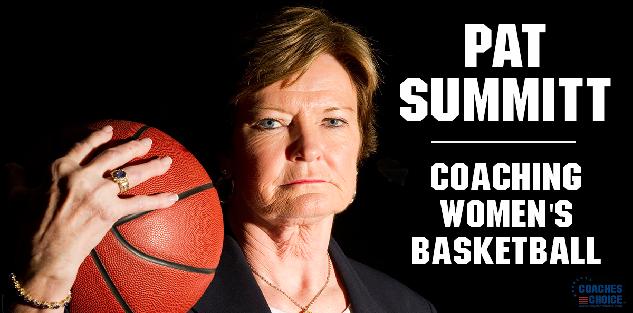The coaching profession has always been intriguing to me. Coaching is different than other occupations because there is not an exact playbook. Nothing on what to study in college, how much education is needed, what to look for in a first job, what level or if there is a need to specialize in a particular area.
During my career, I have been able to have different roles and different levels. From the NBA to the NCAA, women’s professional basketball, the NAIA and high school and middle school. From across the world to across the country.
What I have learned is there is no set path and no set step 1, 2, 3 for coaches to follow. What I also learned early in my career was to seek out and get advice from other coaches. I became a head coach in college at the age of 26. There was no internet, no social media, no online training.
I was on a quest to find out How can I improve as a coach?
I had to figure it out. I asked questions. A lot of questions. I started to pick as many brains as possible to get as much information as possible. From academics to marketing, to running a camp, to communication skills, to how to beat a press, how to attack a trapping zone, to what to do late in the game. I asked coaches and others involved in the game of what does it take for a coach to advance in the profession.
Now, later in my career I still ask a lot of questions. But my goal is different now. I want to find out not only for myself, but for other coaches as well.

How can I help a younger coach, a frustrated coach, someone looking to making a career change into coaching or a veteran coach like me who just wants to learn?
Recently I asked individuals I knew who were either in the profession or had been in the business for input. Here is what I asked them
“If you were to give advice what would you tell a young coach about how to advance in the coaching profession?”
This advice could be how to prepare for the next job or how to improve in their craft to be the very best where they are right now.
Take the advice from coaches who have been there. They say experience is the best teacher. Not always true. You can use someone else's experience to help make your path more smooth. If you can avoid pitfalls and wrong steps why not take the advice of someone who has already walked the path?
Enjoy the input from those from all levels and all roles across the country.
“Communicate, be confident, prepared and precise. Players will see a lack of confidence and preparation as uncertainty. Therefore they will not trust you. Tell them your plan and the time in which you will work. Players work harder when they know the beginning time and most importantly the ending time.
I keep a quote in the back of my mind from Bear Bryant: "I cannot treat all players the same, but I can treat them all fairly." No one is above the team. Every player will have responsibilities, some more than others. Those that have more are required to do more. It is important that this is communicated. It is very important to listen to your players, be willing to learn from them and implement their thoughts.
If a coach is a former player, it is important not to compare players to himself or his playing days. Players resent comparisons and the coach will become frustrated.”
Keith Askins
Miami Heat
Director of College and Pro Scouting/Assistant General Manager
“I’m a pretty good story when it comes to this topic… I didn’t play college basketball and was a self-starter in the business.
1. Network, Network, Network… with the right guys. Drop notes in the mail, best way. Texts are so impersonal.
2. Work hard. People will see your hard work and appreciate it
3. Be humble. You may have to sweep the floor, I still do that’s ok.
4. Get coaching experience no matter the level. I was an assistant HS coach when in college
5. Get your Master’s degree so that you can apply for all jobs, no limitations on your degree.
6. Work the camp circuit. Camps are a great way to meet coaches in a comfortable environment.
7. Don’t worry about the money … only a very few make the millions.
8. Attend Clinics and learn as much as you can.
9. Be willing to relocate…”
Joe Esposito
University of Memphis
Assistant Basketball Coach
“Best advice I was ever given -
"Make yourself invaluable to the person you work for."
"Be able to do or handle things in every part of a program, so you always have a job regardless of the level."
"Don't wait or ask for a coach to tell you why to do. Bring ideas to them and seek them out."
Steve Prohm
Iowa State
Head Coach
“Young coaches should expose themselves in as many basketball activities as possible and develop a network of friends and associates that will promote you to others. One of the best ways to position yourself to college coaches is working their summer camp. Great camp workers impress coaches and are hired more frequently because of it. Go visit with coaches in the summer and talk X's and O's. Start your own coaching clinic. It doesn't matter how small, it shows initiative and giving back to the game. Run your own summer basketball camps, which displays leadership and organization. Make the rounds at HS State tournaments, SEC tournament, Final Four, AAU tournaments, etc. If you want opportunities to present, themselves get out there and meet people and show them what a Stud you are.”

Joe Dean
Birmingham Southern
Athletic Director
“Imagine a house. First is your foundation… and that starts with your passion. Your passion NEEDS to be for helping young men/women grow as a person. It all stems from that. If that is not the reason you are coaching, then your run in this business will be short. It may be good (or even great) for a few years, but it will never be prolonged. If your passion stems from helping young people grow and to become the best version of themselves, you have a fighting chance to be in this for the long-run. If that is the foundation, everything else is built from there.
The walls of the house are the answers to the following questions: 1) Do you have a passion and love for the game of basketball? 2) Are you able to be great teachers (and listener) to individuals, not just a collective whole? 3) Are you willing to sacrifice? 4) Are you a moral and ethical person? Those four questions will determine how sturdy the walls of your house are. If you have a passion for the game of basketball, you will immerse yourself in studying the in’s and out’s of the game from coaches at all levels and you will embrace studying tape of games, opponents, workouts, etc. That will drive your knowledge of the game, which will make you a better teacher of the game. Being able to dissect tiny bits of information on the fly to help teach the game to an individual and not just what is “suppose” to be said. Each player will hear your message differently based on their IQ, your tone, your temper, your distance, their fatigue, their mood, etc. Can you accurately communicate (verbally and nonverbally) and teach them so that they can learn?
Moreover, you need to sacrifice. You can’t just rise to the top of the coaching ranks without having to sacrifice quite a bit. Sometimes it’s time, money, relationships, distance, different opportunities, etc. What are you willing to sacrifice? Sometimes you will have to draw a line for family and your career, but when will that happen? Figure out what you are willing to give up to maybe make it in this coaching business?
Finally, none of it will matter if you don’t have morals or ethics. Your walls will crash to the ground faster than you can get out from under it and you will be crushed, along with the people surrounding you. It’s not just knowing right from wrong, but acting on right vs. wrong. Doing what’s right and that’s often hard to not do when the glamour or fame tempts you otherwise.
Last, but not least, every house needs a roof over their head. Your roof is your mentors. Who is willing to take you under their wing and advise you and keep you safe & warm until you are ready to leave the house? Who is willing to protect you from some bad storms and do their best to make sure you have what you need (IQ, advice, experience, etc.) to be the best version of yourself (like you do for others)?”
Andrew Farrell
Southeast Missouri State University
Assistant Coach
Rising Coaches Elite Founder
“First piece of advice comes from our friend and mentor Coach Meyer, and that advice is too "suck scum." In other words, be willing to do anything and everything in your current job to make yourself invaluable and seemingly irreplaceable. Too many young coaches (and even seasoned coaches) spend so much time working on their next job that they don't do their current job well. "Own" your current job and your reputation will open other doors.
Second, it is important to network. The more people you network with, the more opportunities that will come your way. Regarding networking, be open-minded and willing to meet, get to know, and stay in touch with all. I was once told a story that Rick Callahan, who was at the time a manager at NAIA Salem College worked Jim Boeheim's camp at Syracuse where he met and become friends with North Carolina's third assistant Eddie Fogler. Later, when Fogler took the head coaching job at Wichita State, he hired Callahan as an assistant coach -- from NAIA manager to Division I assistant. Callahan followed Fogler to Vanderbilt and South Carolina becoming Fogler's Associate Head Coach.
Regarding networking, I'm also a big believer in note writing -- something I learned from the late Stu Aberdeen. While email is effective, a handwritten note still goes a long way.
Third, have a social media plan. Social media is a way of creating your brand. Those serious in rising in the profession should invest time and even some money to meet with specialists and map out plan. Social media is not something to take lightly and a poor tweet or Facebook post and cost you a job down the road. Everything from your content to who you follow speaks volumes about who you are and what you stand for and more and more athletic departments will research this in the vetting process.
Fourth, avoid being a specialist coach -- aka. "Recruiting Coordinator," "Post Coach," etc. be well versed in all phases of the game. Being a specialist will limit your opportunities.
For those at the high school, don't get all caught up on being a DI coach. There are great jobs and head coaches on the NAIA, DII and DIII level. These are great places to learn and develop your craft.
Finally, you must be a continual learner. Always look to grow your knowledge. Attending clinics is a great to expand your knowledge and make contacts at the same time. Visit with other coaches, attend their practices.”
Bob Starkey
Texas A&M
Assistant Coach
“Be the first coach to the office and last coach to leave. Never let the head coach beat you in or you leave before he does!
Your job is to take care of everything for your boss and take it off his plate - do things before he asks you to get them done so when he asks you can say already taken care of! Be a self-starter
Loyalty to the head coach you work for is the most important thing - he hired you! You want the same respect when you become a head coach!
Spend all your time making the program you work for better - not working to get the next job - it always catches up with those guys!
Don't negative recruit - coaches that have to talk bad about other programs obviously have nothing to brag about on their own!
Get to know people on campus outside athletics - custodians, housing, cafeteria, admissions, campus police, business office, student life - they will help make your life easier and can get things done quickly for you if you treat them right!
You can't have a MILLION DOLLAR dream on a MINIMUM WAGE work ethic.”
Jeff Moore
Northwestern State University
Assistant Coach
“Go to as many coach related things as possible. Take your wife when you can, because she needs to be a solution, not another problem. Take notes, ask questions and enjoy the fellowship of the people you meet. It doesn't last long.”
Larry Bagley
Retired High School and College Coach
Current Louisiana State Representative
“Be around good people and be the best you can where you are. You are most likely to get your first job from someone you have worked with so you are really interviewing every day. Every job I've gotten is due to a tie from my time at Clemson at my very first job.”
Will Wade
LSU
Head Coach
“Pick a successful coach and program from a different sport (and different school) and study them..effective leadership and ability to manage a program is critical”
Brian Ayers
Belmont University
Assistant Coach
“First, make yourself irreplaceable in the current role. Be someone who can get things done. Second, have a passion for recruiting. Third, network up, sideways, and down. Up to where you want to be, sideways with people in the same situation, and down to others. Lastly, be a great person who has a positive attitude and would never hurt the program with off the court issues."
Erik Konkol
Louisiana Tech
Head Coach
“I think the number one piece of advice I would give them is to develop a skill set or a specific skill that can allow them to add value to staff immediately. Whether that's being good with video, operations, player development, scouting, being knowledgeable about recruiting and knowing players, photo shop, social media/marketing, etc. Some are going to have more experience/knowledge in these areas than others but if they want to
A) gain entry into the profession
B) last and advance in the profession... Then focus on acquiring and developing skills that can help you be a difference maker for a program.
To truly do, so you must have an insatiable work ethic, a keen attention to detail and a desire for continual improvement/learning.
And the last thing I would say is... Be loyal to your head coach. Serve and support his vision. "
Bryan Tibaldi
Depaul
Assistant Coach
You see there is no blueprint in the coaching profession. But there are a lot of ways to get from where you are now to where you want to be.
Maybe you want another role in the profession, or to coach at another level, or you just want to maximize your ability. Hopefully, the advice here can help you in those areas.
If you would like to see other questions asked to coaches who have been there before or any other topic, please email me at coachkelsey@coachtube.com.








 .
.







